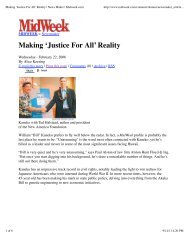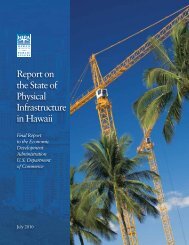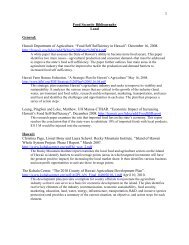Hawai'i Fisheries Initiative - The Hawaii Institute for Public Affairs
Hawai'i Fisheries Initiative - The Hawaii Institute for Public Affairs
Hawai'i Fisheries Initiative - The Hawaii Institute for Public Affairs
You also want an ePaper? Increase the reach of your titles
YUMPU automatically turns print PDFs into web optimized ePapers that Google loves.
Regional Trends,<br />
Wholesale<br />
Markets,<br />
Quality Control<br />
and Safety,<br />
and Consumer<br />
Education<br />
Regional Trends Affecting Hawai‘i’s<br />
Fishing Industry<br />
In 2003, the U.S. Coast Guard conducted<br />
regional “listening sessions,” gathering<br />
in<strong>for</strong>mation from commercial and<br />
recreational fishing industry representatives,<br />
academia, non-governmental organizations,<br />
federal and state en<strong>for</strong>cement agencies,<br />
and fisheries managers. Honolulu session<br />
participants included NOAA Pacific Islands<br />
Regional Office, NOAA En<strong>for</strong>cement,<br />
Wespac, Hawai‘i Department of Aquatic<br />
Resources, and the Hawai‘i Longline<br />
Association (representing its more than 200<br />
members). Regional trends were identified<br />
and included:<br />
u Expansion of the <strong>for</strong>eign fishing fleet is a<br />
significant threat to fish stock sustainability.<br />
u <strong>The</strong> western Pacific is not viewed<br />
by large U.S. businesses as an area to target<br />
<strong>for</strong> expansion.<br />
u Aquaculture will continue to grow in<br />
Hawai‘i. Leaders in the private sector,<br />
University of Hawai‘i, and Oceanic <strong>Institute</strong><br />
have made significant strides in positioning<br />
Hawai‘i as an aquaculture research and<br />
development hub. 57<br />
u An experimental swordfish operation –<br />
shallow-set longlining – opened in 2004<br />
after being closed due to interactions with<br />
endangered species. <strong>The</strong>re are 30 active<br />
vessels in this limited-entry fishery. Full<br />
observer coverage and significant reported<br />
successes through changes in gear and<br />
techniques are likely to lead to increased<br />
opportunity in this fishery. 58<br />
u Illegal, unregulated, and unreported fishing<br />
is expected to increase.<br />
u Wholesale catch prices will not keep pace<br />
with the rising cost of fishing operations. 59<br />
Wholesale Markets <strong>for</strong><br />
Hawai‘i’s Seafood<br />
<strong>Fisheries</strong> management measures,<br />
regulations, and trade policies (state,<br />
national, and international) affect Hawai‘i’s<br />
seafood supply, demand, and pricing.<br />
Consumer concern over fishing<br />
practices – dolphin/tuna interactions in<br />
the purse-seine fleets, high-seas driftnets,<br />
ocean-bottom trawling, or longlining and<br />
its bycatch issues – plays a big part in<br />
national and international policies, which<br />
in turn affect the local seafood market.<br />
Seafood safety and sustainability of fishing<br />
practices is of concern to an increasingly<br />
sophisticated consumer base. 60<br />
Commercial fishers on O‘ahu and Hawai‘i<br />
primarily sell their catch through the<br />
fish auctions; fishers on other islands<br />
sell directly to wholesalers and retailers.<br />
Wholesalers buy, process, export, and sell<br />
fish to smaller wholesalers, supermarkets,<br />
fish markets, and restaurants, which<br />
buy 10-15 percent of Hawai‘i’s fresh<br />
catch. Some fishers sell their catch on<br />
consignment, thereby accessing the<br />
export markets directly. Other fishers,<br />
usually recreational fishers or small-time<br />
commercial fishers, sell directly to<br />
consumers on the roadside. 61<br />
Fish auctions are unique to Hawai‘i.<br />
While fishing fleets elsewhere typically<br />
18







